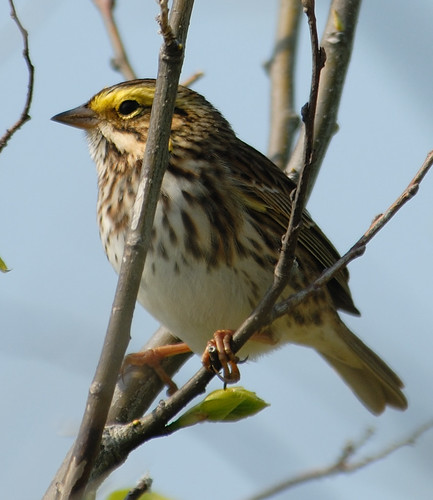The weather was splendid and the birds were plentiful for the 24th annual World Series of Birding. The Sandy Hook Century Run team, led by senior naturalist Scott Barnes, associate naturalist Linda Mack, and me, racked up a very respectable tally of 126 species from 5:30 AM to 9:00 PM. We had one of the biggest groups for the Century Run's history with around 30 participants. Extra credit goes to the 12 hardy folks who stuck around until the very end.
We started the morning birding "Plum Island", which is more of a peninsula than an island, where we found birds such as Solitary Sandpiper, Common Loon, Clapper Rail, Willet, and Oystercatcher. We then quickly headed to the far north end of Sandy Hook, which is a good migrant trap. We found a few small pockets of warblers, tons of orioles, tons of Yellow Warblers, and a small handful of Rose-breasted Grosbeaks. The oddest find of the day was a large escaped parrot, which was most likely an Eastern Rosella from Australia.

What the heck am I doing here? (pic from Wiki)
We did some more woodland birding where we found perhaps our "best" bird of the day - 2-3 Summer Tanagers in various plumages. They put on quite a show, at times being joined by small groups of Scarlet Tanagers. The trees looked like they were covered in Christmas ornaments. We also added some additional warblers to our list including Ovenbird, Redstart, and Chestnut-sided. Veery and Hermit Thrush were also observed.

Lunch
Lunchtime was spent lounging at the observation deck on Spermaceti Cove. This is one of those places where you just never know what will come by. Nothing exceptionally rare appeared, but we did find a Black Skimmer, Black-bellied Plover, and Peregrine Falcon. A close-feeding Black-crowned Night Heron put on quite a show eating killies from the water's edge.

Black-crowned Night Heron
After lunch we unsuccessfully searched the bay for a lingering Long-tailed Duck or Red-breasted Merganser with no luck, but we did find our only Least Flycatcher. The afternoon lull had set in, but we pressed on. We made our obligatory stop to see a Piping Plover in one of its protected enclosures. The foxes and raccoons really do a number on them at Sandy Hook and electrified fencing has been installed to keep them out. A long scan of the ocean yielded a flock of Red-breasted Mergansers and a Bonaparte's Gull.
We then headed back to the wooded areas to find our "missing" Eastern Phoebe and Black-capped Chickadees. After some heavy searching, one of the leaders in the group heard a Chickadee, but no Phoebe would be found on this day! Next, we stopped for dinner at the Sandy Hook Bird Observatory and then headed back to the north end for a long beach walk - AKA the "Death March."
It was a worthy haul out to the beach. We were able to find 4 new birds for the list. A few members of the group walked out a bit more and found a Lesser Black-backed Gull and a female Black Scoter. So, 6 new birds were seen on this one walk.
Darkness was approaching and we waited and waited for a Nighthawk to appear. No luck there, but we did hear a calling Least Bittern (very faint, but very cool) and Marsh Wren. We finished off the day by standing in the dark waiting for a Whip-poor-will or other night bird to call. We settled for a distant silhouette of a Great Horned-owl for bird #126!







 Birders can argue ad nauseum regarding the "must have" books for any new birder. Aside from preferred field guides, my argument would include several supplemental books. At the top of that supplemental list are Sibley's
Birders can argue ad nauseum regarding the "must have" books for any new birder. Aside from preferred field guides, my argument would include several supplemental books. At the top of that supplemental list are Sibley's 
 Have you ever heard a sound in your dream and then woke up to discover that the sounds is actually in real life? This happened to me this morning. I can't remember what I was doing in my dream (I usually can't), but I was definitely hearing the song of one of the Catharus thrushes (Gray-cheeked, Bicknell's, Swainson's, Hermit, Veery). I know Veery and Hermit well, but I always confuse the other three. Sure enough, my eyes popped open and I was still hearing the sound! It took me a few moments to realize that I was awake. I jumped out of bed and ripped open our sliding glass door. Sure enough, there was a thrush singing right on the other side of our fence. I was thinking "Swainson's", so I popped open the laptop and verified my thoughts. Sure enough, a
Have you ever heard a sound in your dream and then woke up to discover that the sounds is actually in real life? This happened to me this morning. I can't remember what I was doing in my dream (I usually can't), but I was definitely hearing the song of one of the Catharus thrushes (Gray-cheeked, Bicknell's, Swainson's, Hermit, Veery). I know Veery and Hermit well, but I always confuse the other three. Sure enough, my eyes popped open and I was still hearing the sound! It took me a few moments to realize that I was awake. I jumped out of bed and ripped open our sliding glass door. Sure enough, there was a thrush singing right on the other side of our fence. I was thinking "Swainson's", so I popped open the laptop and verified my thoughts. Sure enough, a 








 Well, prior to just hearing the sound of my beloved
Well, prior to just hearing the sound of my beloved 
